Best Hunting Rifles & Calibres for Africa - If you are visiting Africa to hunt and are deciding on a rifle and calibre combination, African professional hunter Giles Allcock provides some invaluable advice.
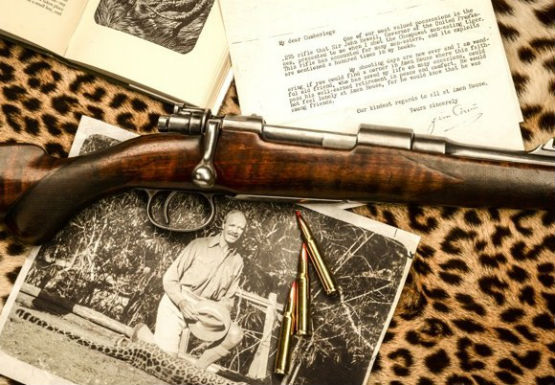
African rifles are more than just wood and steel. The genre is rich in romance, tradition and history including several important milestones of firearms development. African rifles served as the primary test-bed for the introduction of nitrocellulose gunpowder—modern smokeless powder—to sporting firearms.
When the black powder era was replaced with smokeless cartridges like the .500, these were loaded with cordite and rechristened as “Nitro Express” cartridges.
The term “Nitro Express” was coined by James Purdey the younger in 1856. The term "Express", derived from the express train that at the time transported members of the British public faster than any other transport around Mainland Britain. The term was therefore designed to publicise the bullet velocity of his double rifles and became common parlance for many rifle cartridges. The addition of the word “Nitro” stemmed from the propellant used in these cartridges, cordite, which is composed of nitrocellulose and nitroglycerine. Of course the Nitro Express cartridges produced much faster velocities than their black powder predecessors.
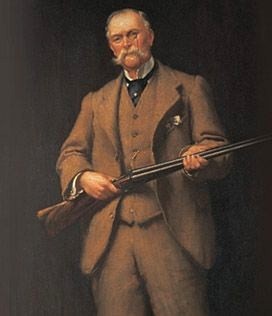 With the increased velocity of Nitro Express cartridges came increased chamber pressures that prompted gun makers of the day to develop stronger, more robust rifle actions. These were side-by-side rifles, doubles, destined for the far-flung corners of the British Empire in the hands of officers and gentlemen of the realm.
With the increased velocity of Nitro Express cartridges came increased chamber pressures that prompted gun makers of the day to develop stronger, more robust rifle actions. These were side-by-side rifles, doubles, destined for the far-flung corners of the British Empire in the hands of officers and gentlemen of the realm.
Later, when Mauser perfected the bolt action rifle, it was British gun makers catering to the African trade who developed a sporting version of Mauser’s military rifle and introduced such classic cartridges as the .404 Jeffery, 416 Rigby and the granddaddy of all African cartridges, Holland’s .375 Magnum.
Then as now, African rifles fell into two classes: big-game rifles and plains-game rifles. “Big game” meant elephant, rhino and buffalo, while plains game included all the antelopes and soft-skinned dangerous game. Naturally, the lines between the types of game that could be hunted with the respective classes of rifles often blurred, with the most extreme example being William Dalrymple Maitland Bell who shot 1,011 elephant with a .275 Rigby (exactly the same as a 7x57mm Mauser).
Generally speaking, in the heyday of African rifles, big game was hunted with a double, while plains game was hunted with a bolt-action, but there were exceptions. When President Roosevelt took his 1909 safari, he took a Holland & Holland Royal double, a .405 Winchester lever-action and a .30-’06 Springfield bolt-action. He proclaimed his .405 Win. to be “excellent lion medicine."
Today, African rifles still divide into big game and plains game categories. The action type is no longer demarcated as clearly as it was in the “champagne era” of safaris in the 1920s when only the very rich went on safari. A bolt-action is by far the dominant style for both categories today.
Plains-Game Rifles
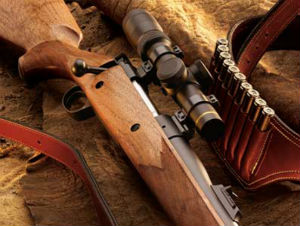 The plains-game rifle deals with everything except three thick-skinned, heavily boned animals, Elephant, Buffalo and Rhino, Hippo also falls into this band of thick-skinned animals.
The plains-game rifle deals with everything except three thick-skinned, heavily boned animals, Elephant, Buffalo and Rhino, Hippo also falls into this band of thick-skinned animals.
The category goes from the 2.25Kg dik-dik to 900Kg eland. It includes game with tooth, fang, claw and horn. Soft-skinned dangerous game such as lion, leopard and hyena are included. The spectrum of plains game is truly vast.
Plains-game rifles can, in theory, include single-shots, doubles, bolt-actions and lever-actions, but in practice, virtually everyone uses a bolt-action. About the only action type that’s never used, because they’re illegal in African countries, is a semi automatic.
Bolt-action rifles dominate in the hands of both clients and professional hunters (PHs). The reasons are obvious: Bolt-actions are affordable, accurate, reliable and available in many different brands and calibers. Traditionalists will say that a Mauser action is the classic choice for Africa, and I wouldn’t disagree, however, there’s absolutely nothing wrong with other versions of the turn-bolt.
Controlled feed vs Push feed
Controlled Feed
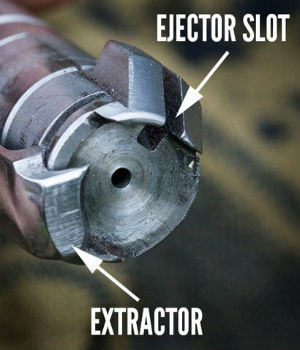 Controlled-round feeding is another matter. When you push forward on the bolt to pick up a fresh cartridge from the magazine, the rim of a new round slips under a Mauser’s claw extractor so that the cartridge is “controlled” as it’s pushed into the chamber. If for some reason, the shooter pulls backward in mid-stroke, the round is still retained by a Mauser’s bolt, preventing a jam.
Controlled-round feeding is another matter. When you push forward on the bolt to pick up a fresh cartridge from the magazine, the rim of a new round slips under a Mauser’s claw extractor so that the cartridge is “controlled” as it’s pushed into the chamber. If for some reason, the shooter pulls backward in mid-stroke, the round is still retained by a Mauser’s bolt, preventing a jam.
Push Feed
With a push-feed system, as the shooter shoves the bolt forward, it pushes a round out of the magazine and scoots it along into the chamber. If the shooter hesitates and pulls backward on the bolt before the round is chambered, at which time the extractor snaps over the rim to grab the cartridge, then a jam ensues.
Notice that the key here is the shooter—pilot error, in other words. There’s no problem with a push-feed system unless the shooter short-strokes the bolt. Because of that, a push-feed action is not any “worse” than a Mauser. It simply requires a shooter to handle to his rifle properly.
On the other hand, there’s an important argument against Mauser-derived actions that you hardly ever hear about. It has to do with the three-position safety made famous on the Winchester Model 70, which is the best known of all the Mauser-derived actions.
The three-position safety gives the shooter the option of blocking the sear and locking the bolt handle down (the safety all the way to rear), blocking the sear but allowing the bolt handle to be raised (middle position) or disengaging the safety entirely (all the way forward). The theory behind the middle position is that the round in the chamber can be unloaded even while the sear is blocked, hence it’s “more safe” than a Mauser two-position safety.
One major flaw is that if the bolt is slightly lifted while the safety is in the middle position—which can easily happen in the field—the safety becomes locked! You can’t push it forward to “fire.” For this reason, never use the middle position while hunting.
Given that there are pros and cons to all the various brands of bolt-action rifles, you have a lot of good choices available. My favorite is the rifleman’s rifle, Winchester’s immortal Model 70 in both pre-64 and the reintroduced “classic” versions. However, hunt with what you like and don’t let anyone try to tell you that a Mauser is “better.”
Calibre Choices
Plains-game calibers are almost as diverse as the selection of game that can be hunted with them. You can start with a .22 Hornet and, without stretching things, go up to .416 Rigby.
Make a point of asking your PH what calibers they like to see clients bring, and the answer will usually be two hands-down favorites: .300 Win. Mag. and .375 H&H Magnum. Of course PH’s all agreed that a client should bring the gun that he or she shoots the best, regardless of caliber. Accuracy comes first.
The .30 caliber is an all-time favorite plains-game bore size. Given the “right” bullet you can kill anything in Africa other than thick-skinned game with a .30 caliber.
The .300 H&H appeals because it’s such a vintage African caliber even though any of the .300 magnums—short, ultra or in between—equal or surpass its velocity.
Without question, the .375 H&H is the best all-around choice for Africa, plains game and big game included. With a solid bullet, a .375 is fine for elephant.
If you simply want lots of velocity, Roy Weatherby took care of that with the immortal .300 Weatherby Magnum, which is a classic in its own right.
African rifles are steeped in romance and nostalgia, and so should their calibers. Avoid anything that’s too modern, and go with old favorites like Bell’s 7x57, Holland’s venerable .300 and .375 Magnums or Roosevelt’s .30-’06. Even the .270 with the correct weight bullet will bring down plenty of Plains game.
Pick your favorite classic caliber and take it to Africa for your plains-game rifle. You’ll shoot it well; enormously satisfying your PH, and you’ll enjoy your safari even more knowing that you are using a great old caliber steeped in hunting history.
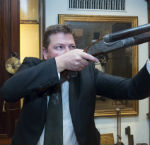 Left: Giles Allcock .
Left: Giles Allcock .
If you are interested in hunting in Africa and would like advice on how to get started then contact:
Alternatively to read more from Giles follow this link: history-and-allure-of-hunting-in-africa



















